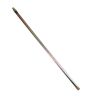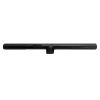AMS Signature Series Soil Augers
Features
- Signature Series is thicker and more durable than traditional threads
- Connection and disassembly with 2 1/2 turns
- Zinc-coated auger extensions improve rust resistance
- Expedited repair and warranty service
- Lifetime technical support
- More
Signature Series Connection
The AMS Signature Series connection is an enhanced version of the already trusted AMS threaded connection. The Signature Series features zinc coated extensions to improve rust resistance as well as a larger capacity auger with no weld or grind marks for easy decontamination. The Signature Series thread design is available on a variety of AMS regular, mud, dutch and sand augers, cross handles, extensions, core samplers, slide hammers and adapters.
Regular Soil Augers
AMS Regular Augers are designed for use in most soil types. The AMS regular soil auger is commonly used for obtaining disturbed soil samples at or near the surface and for boring to depths where soil samples may be obtained with a separate soil sampler or soil core sampler. The bits of the regular soil auger are open to allow entry of small soil clumps and relatively small rocks and particles.
Mud Augers
AMS Mud Augers utilize a laser-cut, open cylinder design for easy removal of heavy, wet, or clay soils. The AMS mud auger features two openings in the cylinder wall to facilitate emptying as well as wider spaced bits than the AMS regular soil auger to ease entry of sticky soils.
Sand Augers
AMS Sand Augers are designed for use in sands and dry soils. The AMS sand auger uses a closed bit design with a restricted opening to prevent the loss of sampled material during retrieval. The sand auger has a cylinder similar to the regular soil auger, but the inner edges of the sand auger bits touch at their mid point to make the sand auger a much more reliable auger in loose, unconsolidated soil conditions.
Dutch Augers
The AMS Dutch Auger allows you to easily collect disturbed soil samples in heavily rooted areas. Hand forged from high-carbon steel and honed to a fine cutting edge, this auger will cut through highly fibrous and heavily rooted soils. It is excellent for use in, forests, vineyards and orchards. The unique open design of the dutch auger also allows for easier removal of hard or wet soils.
In The News
It’s Time to React to Water Quality: Proteus Multiparameter Probe aboard NexSens Buoy
Water quality monitoring is essential for safeguarding public health, protecting ecosystems, and ensuring the sustainability of water resources. Contaminants such as industrial pollutants, agricultural runoff, and sewage discharge can severely impact aquatic life and pose serious risks to human health if left unchecked. Traditionally, water quality monitoring has been a slow and labor-intensive process, requiring samples to be collected, transported to a lab, and analyzed—a process that can take days. However, with the advancement of real-time sensor technology, environmental agencies, researchers, and industries can now monitor water quality instantly.
Read MoreSafeguarding Communities with Real-Time Flood Monitoring in the City of Hazelwood
The City of Hazelwood is a suburb in St. Louis County, Missouri, home to around 25,500 people. Recently, the community has suffered increased flash flooding following severe storms, prompting the need for the installation of a flood monitoring system. In 2022, a NexSens X2 data logger was installed to monitor water level and rainfall in real-time, with the aim of reducing the loss of life and property as a result of extreme weather events. [caption id="attachment_39411" align="alignnone" width="940"] The latest flood event at Coldwater Creek, where the water level rose by 14 feet, exceeding the height of the X2 by three feet. The sensor can be seen behind the wall that usually contains the Creek.
Read MoreSave our Bogs! Culture, Conservation and Climate Action in Ireland’s Peatlands
Characterized by long-term accumulation under waterlogged conditions, peatlands exist on every continent and account for 3-4% of the global land surface . Small but mighty, these often overlooked wetland environments are estimated to hold as much as one-third of the world's organic carbon in their soil—twice the amount found in the entirety of the Earth's forest biomass. While healthy peatlands can trap and store carbon, regulate water, and provide important habitats for rare species, human alteration has disturbed peatland carbon and nitrogen cycles on a global scale. Approximately 12% of the world’s peatlands have been drained and degraded through conversion for agriculture, forestry, infrastructure development, and other uses.
Read More








































